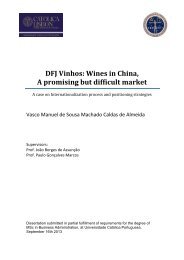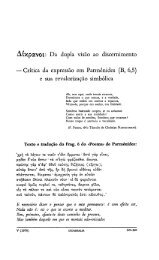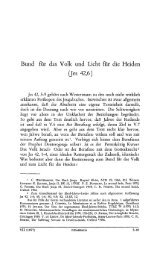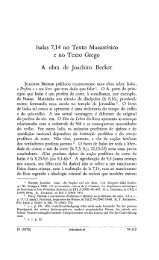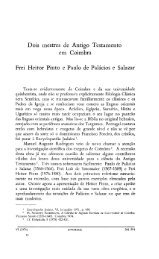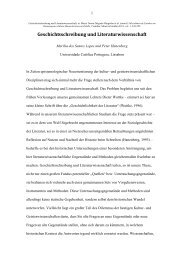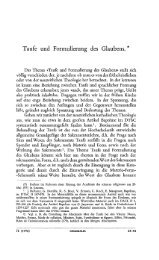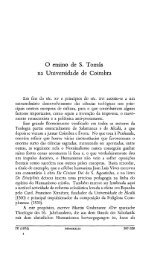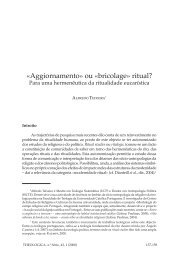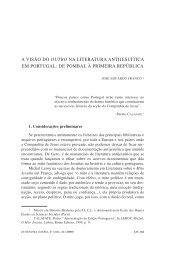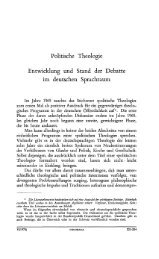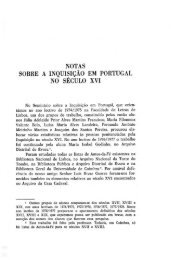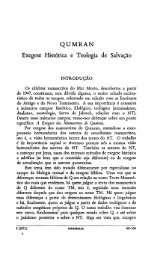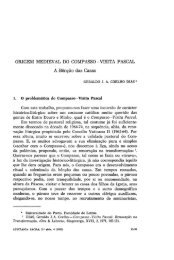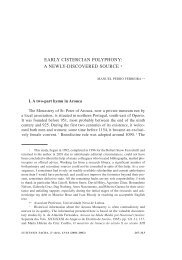Review: Technology, Chemistry an«!Microbiology of Whey Cheeses
Review: Technology, Chemistry an«!Microbiology of Whey Cheeses
Review: Technology, Chemistry an«!Microbiology of Whey Cheeses
You also want an ePaper? Increase the reach of your titles
YUMPU automatically turns print PDFs into web optimized ePapers that Google loves.
<strong>Review</strong>: <strong>Technology</strong>, <strong>Chemistry</strong> <strong>an«</strong>! <strong>Microbiology</strong><br />
<strong>of</strong> <strong>Whey</strong> <strong>Cheeses</strong><br />
M.E. Pintado/ A.C. Macedol.2 and F.X. Malcatal.*<br />
IEscola Superior de Biotecnologia, Universidade Católica Portuguesa, Rua Dr. António Bernardino de Almeida,<br />
P-4200-072 Porto, Portugal<br />
2/nstituto Superior da Maia, Avenida Carlos Oliveira Campos, Castelo da Maia, 4470 Maia, Portugal<br />
In whey cheese manufacture, whey, plain or added with milk, is heated by direct fire, bubbling steam or<br />
alternatively in jacketed vats. In some cases, salts or organic acids are previously added. At 80-85 °C, the first<br />
partic1es<strong>of</strong> curd form; at 85-95 °C, the curd may be cooked for a few minutes to reduce moisture content and/or to<br />
obtain the desirable leveI <strong>of</strong> browning. After drainage at room temperature during molding for ca. 4 h, whey<br />
cheese is stored at ca. 4 oCoThe typical mass yield is 6%, but addition <strong>of</strong> milk, calcium salts and preliminary<br />
concentration <strong>of</strong> protein (by condensation or ultrafiltration techniques) may increase yield considerably. Some<br />
types <strong>of</strong> whey cheeses are supposed to be consumed within a short time upon manufacture (e.g., Ricotta,<br />
Requeijão and Manouri), whereas others.bear a longer shelf life (e.g., Gjetost, Mysost and Myzithra). <strong>Whey</strong><br />
cheeses are significantly different from one another in terms <strong>of</strong> chemical composition, which is mainly due to<br />
variations in the source and type <strong>of</strong> whey, as well á'sto the processing practices followed. Moisture content and pH<br />
<strong>of</strong> whey cheeses are usually high and favor microorganism growth (molds, yeasts, lactic acid bacteria and<br />
Enterobacteriaceae account for the dominant micr<strong>of</strong>lora in these cheeses). Adequate packaging <strong>of</strong>whey cheeses<br />
should be provided, and legislation should be prepared to fix standard characteristics <strong>of</strong> each type <strong>of</strong> whey cheese,<br />
and hence protect typical products from adulteration and fakes. Marketing efforts should also be aimed at<br />
increasing whey cheese consumption, either directly or incorporated in desserts, snack dips and pasta-type dishes.<br />
Key Words: whey cheeses, manufacture, micr<strong>of</strong>lora, composition<br />
En la fabricación de quesos de suero, el suero, solo o con adición de leche, se calienta directamente con fuego, con<br />
burbujeo de vapor o alternativamente en recipientes con camisas de calor. En algunos caos se afiaden sales o<br />
ácidos orgánicos previamente. Entre 80 y 85 °C se forman Ias primeras partículas dei cuajo; entre 85 y 95 °C el<br />
cuajo debe cocerse durante unos minutos para reducir el contenido de agua y además producir un pardeamiento si<br />
se desea. Después dei drenaje en el molde y a temperatura ambiente durante aproximadamente 4 horas, el queso se<br />
almacena a 4 oCoEl rendimiento másico es aproximadamente dei 6%, aunque la adición de leche, sales decalcio y<br />
una concentración previa de Ias proteínas, pueden aumentarIo considerablemente. Se supone que algunos de los<br />
quesos de suero deben consumirse poco después su elaboración (p.e., Ricotta, Requeijão and Manouri), mientras<br />
que otros tienen vidas útiles más largas (p.e., Gjetost, Mysost and Myzithra). Los quesos de suero son<br />
significativamente diferentes unosnspecto a otros en cuanto a su composición química debido principalmente a r<br />
Ias variaciones en el origen y el tipo de suero, así como a Ia forma deelaboración. El contenido de agua y el pH de<br />
los quesos de suero son generalmente altos, lo que favorece el crecimiento de microorganismos (hongos,<br />
levaduras, bacterias acidolácticas y Enterobacteriaceae componen Ia micr<strong>of</strong>lora de estos quesos). Estos quesos<br />
deberían envasarse adecuadamente y establecerse Ia legislación que fije las características estándar de cada tipo<br />
de queso y así proteger ai producto de adulteraciones y fraudes. También debe promoverse su consumo, tanto<br />
directo como incorporado en pasteles, galletitas y platos de pasta.<br />
Palabras Clave: quesos de suero, fabricación, micr<strong>of</strong>lora, composición<br />
*To whom correspondence should be sent<br />
(e-maU: xmalcata@esb.ucp.pt).<br />
INTRODUCTION<br />
<strong>Whey</strong> is the aqueous portion <strong>of</strong> milk obtained following<br />
acid-, heat- or rennet-driven coagulation. It is an opaque liquid<br />
possessing a greenish-yellow color, with total solid content<br />
generally ranging in 6.0-6.5% (w/v) and a biological<br />
oxygen demand (BOD) <strong>of</strong> at least 30,000. In Mesopotamia,<br />
about 5,000 B.C.,Kanana discovered that ~arm milk stored<br />
in a bag made <strong>of</strong> fresh stomach skin <strong>of</strong> sheep (or goat) pro-<br />
105
106 M.E. PINTADO, A.C. MACEDO AND F.X. MALCATA<br />
duced curds and, concomitantly, whey (Malcata, 1991).<br />
Later, nomad shepherds started boiling whey in copper kettles<br />
and eventualIy obtained a nourishing solid food<br />
(Kosikowski, 1982b).<br />
<strong>Whey</strong> cheeses are manufactured alI over the world, usualIy<br />
according to traditional protocols and in smalI scale, via<br />
denaturation <strong>of</strong> whey proteins (which also have associated<br />
residual fat). These cheese~ bear distinct names, depending<br />
on the country and region where they originate (Table 1).<br />
<strong>Whey</strong> cheeses have been manufactured chiefly from<br />
ovine whey in the Mediterranean basin, owing not only to<br />
the economic importance <strong>of</strong> such ruminants in that area, but<br />
also to its high protein content; the lower protein contents <strong>of</strong><br />
bovine and caprine wheys lead in fact to lower yields <strong>of</strong> the<br />
corresponding whey cheeses. Ricotta is the most important,<br />
and welI-known, whey cheese in the world; it was originalIy<br />
a product <strong>of</strong> Italy, but in recent years, Ricotta has become<br />
rather popular in the USA. This cheese has been manufactured<br />
from whey obtained from buffalo's skim milk, whey<br />
obtained from Cheddar cheese making and paneer whey<br />
(produced by acid precipitation <strong>of</strong> buffalo's milk at high<br />
temperature) (Prajapati and Mathur, 1981).<br />
The literature on whey cheeses is scarce and is virtualIy<br />
limited to Italian, Portuguese, Norwegian and Greek types.<br />
Therefore, only whey cheese from these countries will be<br />
presented and further discussed in this review.<br />
MANUFACTURE<br />
Therrnal denaturation, sequential aggregation and eventual<br />
precipitation perrnit whey proteins be used in the manufacture<br />
<strong>of</strong> s<strong>of</strong>t and semi-s<strong>of</strong>t whey cheeses. In the manufac-<br />
Country<br />
Norway<br />
Switzerland<br />
Portugal<br />
Spain<br />
France<br />
Germany<br />
Greece<br />
Italy<br />
Malta<br />
Cyprus<br />
Romania<br />
Macedonia<br />
Czechoslovakia<br />
ex-Yugoslavia<br />
ex-USSR<br />
Tunisia<br />
Northern Africa<br />
Lebanon<br />
Israel<br />
Iraq<br />
Argentina<br />
Brazil<br />
USA<br />
Table 1. <strong>Whey</strong> cheeses produced worldwide.<br />
Name <strong>of</strong> <strong>Whey</strong> Cheese<br />
Mysost, Primost, Gjestost, Grubransdalsost<br />
Schottenziegr, Hudelziger, Mascarpone<br />
Requeijão<br />
Requesón .<br />
Serac, Brousse, Broccio, Greuil<br />
Zieger, Schottenzieger, Schabzieger<br />
Manouri, Myzithra, Anthotyros<br />
Ricotta (gentile, pecorina or romana)<br />
Cacio-ricotta<br />
Anari<br />
Ziger, Urda<br />
Urda<br />
Urda, Zincica<br />
Scuta, Puina<br />
Nadigi, Kaukaz<br />
Klila<br />
Nicotta<br />
Kariche<br />
Urda<br />
Lour<br />
Ricotta<br />
Requeijão do Norte, Ricotta fresca<br />
Ricotone, Ricotta<br />
ture <strong>of</strong>these dairy specialties, whey can be used as such, but<br />
a smalI percent <strong>of</strong> milk is <strong>of</strong>ten added; hence, coprecipitation<br />
<strong>of</strong> caseins usualIy occurs when whey cheeses are produced.<br />
Coprecipitation <strong>of</strong> casein may be improved by acidification,<br />
and the maximum yield is obtained when addition<br />
<strong>of</strong> acid is coupled with maintenance <strong>of</strong>low levels <strong>of</strong> calcium<br />
chloride (Hill et aI., 1982).<br />
Ricotta is generalIy sold as a fresh, unripened grainy<br />
cheese, which is white, s<strong>of</strong>t and moist. It is fairly bland, or at<br />
most semi-sweet, when it is manufactured from fresh, sweet<br />
whey. Ricotta was originalIy produced where an important<br />
production <strong>of</strong> ovine milk existed, viz., Lazio, Sicilia and<br />
mainly Sardinia; however, such whey cheeses were later distributed<br />
throughout Italy, and even exported to other countries,<br />
especialIy the USA. In this country, the early Ricotta,<br />
calIed Ricotone, was usualIy produced via high temperature<br />
heating <strong>of</strong> acidified cheese whey. In the eastern USA, the<br />
highest consumer acceptance was achieved when Ricotta<br />
was manufactured with the addition <strong>of</strong> whole milk, or partly<br />
skimmed milk (Kosikowski, 1982a); this product is indeed<br />
s<strong>of</strong>ter and creamier, and possesses a delicate texture and a<br />
pleasant flavor that resembles carameI. Since the 1970s<br />
some patents pertaining to manufacture <strong>of</strong> Ricotta cheese<br />
have been granted (Schmidt et aI., 1972; CarswelI, 1973;<br />
Pontecorvo, 1973; Edwards, 1977; Savaresse, 1981; PrelIa,<br />
1987; Skovhauge and Simonsen, 1988; Rota, 1990;<br />
Magnanini et aI., 1995;Tomatis, 1996; Sassu, 1998). The industrial<br />
processes most commonly found for the manufacture<br />
<strong>of</strong> Ricotta start from sweet whey mixed with 5-10%<br />
(v/v) milk, that has been previously heated to ca. 40-50 OCo<br />
Salt is then added to ca. 0.1% (w/v), and heating is carried on<br />
up to 80-85 oCoAt this stage, an acidification agent is added<br />
(usualIy an aqueous solution <strong>of</strong> citric acid at ca. 0.11 kg/L),<br />
Reference<br />
Jelen and Buchheim, 1976<br />
Kandarakis, 1986<br />
Kandarakis, 1986<br />
Kandarakis, 1986<br />
Kandarakis, 1986<br />
Kandarakis, 1986<br />
Kandarakis, 1986; Anifantakis, 1991<br />
Kosikowski, 1982a,b<br />
Kandarakis, 1986<br />
Williams and Syson, 1984; Kandarakis: 1986<br />
Kandarakis, 1986<br />
Dzilenski et aI., 1975<br />
Kandarakis, 1986<br />
Stefanovic and Djordjevic, 1969; Kosikowski, 1982b<br />
Kandarakis, 1986<br />
Kandarakis, 1986<br />
Kandarakis, 1986<br />
Kandarakis, 1986<br />
Kandarakis, 1986<br />
Kandarakis, 1986<br />
Kandarakis, 1986<br />
Jassen-Escudero and Rodriguez-Amáya, 1981<br />
Kosikowski, 1982b; Kandarakis, 1986
and gentle stirring is provided. Heating and stirring are discontinued<br />
when the curd rises to the free surface <strong>of</strong> the hot<br />
whey (Mathur and Shahani, 1981), and the mixture is then<br />
allowed to rest for ca. 5 minoThe curd is then scooped from<br />
the surface into perforated tins. The whey cheeses are allowed<br />
to drain in those tins for 4-6 h in a cool room, and then<br />
they are covered with parchment and ice. Usually, 1 kg <strong>of</strong><br />
Ricottacan be obtained from 15-20L <strong>of</strong>whey (Mills, 1986),<br />
which corresponds to a yield <strong>of</strong> ca. 6% (w/v) (Kosikowski,<br />
1982a). Weatherup (1986) described a method designed for<br />
Ricotta, which consisted <strong>of</strong>mixing 80% (v/v) Cheddar whey<br />
with 20% (v/v) whole milk, neutralizing to pH 6.5 with sodium<br />
hydroxide, and precipitating at 87 DCafter acidification<br />
to pH 5-6 with citric or acetic acid; these conditions<br />
lead to a yield <strong>of</strong> 12% (w/v). An empirical equation was developed<br />
by Modler and Emmons (1991), which, based on<br />
milk composition, was able to estimate the final yield <strong>of</strong><br />
Ricotta. Meanwhile, the low yield <strong>of</strong> plain whey cheese<br />
urged a few technological changes. In general, addition <strong>of</strong><br />
milk or addition <strong>of</strong> ca1ciumsalts increases overall protein recovery,<br />
as observed by Mathur and Shahani (1977, 1981)<br />
and Shahani (1981) (Table 2); addition <strong>of</strong> those cations at<br />
the 500 ppm leveI may increase recovery <strong>of</strong> proteins from<br />
48.2% up to 65.5%, and up to 77.8% when 2000 ppm is employed<br />
in the case <strong>of</strong> Cheddar whey, provided that neutralization<br />
to pH 6.8 had already been done. The desired fat<br />
leveI may also be reached by directly creaming the Ricotta<br />
curd from whey/dried skim milk mixtures (Shahani, 1981).<br />
An alternative manufacturing process to increase yield is a<br />
preliminary concentration <strong>of</strong> whey. Instead <strong>of</strong> whey obtained<br />
directly fram the cheese vat, Nilson and Streiff (1978)<br />
and Streiff et aI. (1979) preferred condensed whey to produce<br />
Ricotta and thereby obtained higher yields, i.e., increases<br />
from 10.2% (w/v) to 47.2% (w/w) in total solids;<br />
however, the whey cheeses, characterized by a total solids<br />
content above 21% (w/v), were not organoleptically acceptable<br />
because they were coarse, unc1ean and exhibited a<br />
grainy and mealy texture; manufacture <strong>of</strong> Ricotta with ca.<br />
21% (w/v) condensed whey was thus recommended. Furthennore,<br />
acidification with acetic acid produces higher<br />
yields and better final product characteristics than with citric<br />
and lactic acids, and indirect heating praduces greater yields<br />
Table 2. Recovery ot distinct tractions trom whey<br />
systems containing varying amounts ot added milk<br />
(adapted trom Mathur and Shahani, 1981).<br />
Composition 01<br />
System (%, w/w) Recovery 01Protein (%, w/w)<br />
<strong>Whey</strong> Total<br />
<strong>Whey</strong> Whole Milk Caseins Proteins Proteins<br />
100.0 0.0 95.5 30.6 48.2<br />
97.5 2.5 94.7 55.4 64.7<br />
95.0 5.0 94.2 62.0 71.4<br />
90.0 10.0 95.5 61.2 73.3<br />
75.0 25.0 94.4 64.4 79.5<br />
<strong>Whey</strong> Cheese: A <strong>Review</strong><br />
107<br />
<strong>of</strong> curd (and a better curd texture) than direct heating<br />
(Weatherup, 1986; Mahran et aI., 1999).<br />
Additionally, Pereira et aI. (1982) observed that the<br />
rate <strong>of</strong> heating <strong>of</strong> whey did not significantly affect the<br />
characteristics <strong>of</strong> the final Ricotta, except when it was<br />
above 3.5 DC/min;in this latter case, a small reduction in<br />
yield was recorded, as well as a higher retention <strong>of</strong> faL<br />
Holding the temperature at 85 DCfor 10 min led to a finner<br />
final whey cheese.<br />
Increase in the worldwide manufacture <strong>of</strong> Ricotta cheese<br />
to meet a growing demand by the various populations has<br />
been promoting technological optimization <strong>of</strong> Ricotta manufacture<br />
via, namely, concentration <strong>of</strong> proteins by<br />
ultrafiltration <strong>of</strong> a mixture <strong>of</strong> whey and milk, or whole milk<br />
in which no curd partic1es (or fat, for that matter) were lost<br />
prior to heating (Maubo~ and Kosikowski, 1978, 1981;<br />
Maubois, 1980; Nielsen, 1984; Eriksen, 1985) and continuous<br />
production <strong>of</strong> Ricotta, which shows advantages over<br />
conventional protocols owing to reduced capital and operating<br />
costs. In continuous methods, a mixture <strong>of</strong> sweet whey<br />
and 10-20% (v/v) whole milk (with pH adjusted to 6.3) or<br />
plain sweet whey (with pH adjusted to 7) is pasteurized or<br />
subject to HTST or (preferably) UHT procedures, cooled to<br />
85 DCand typically passed through a holding tube (30.5 m<br />
long) at a flow rate <strong>of</strong> ca. 4.5 L/min, with injection <strong>of</strong> citric<br />
acid at a rate <strong>of</strong> 125-150 mL/min. The hot, acidified coagulum<br />
<strong>of</strong> protein is transferred to a slow-moving conveyor belt<br />
made <strong>of</strong> a nylon mesh with 43% open area (to allow whey<br />
separation from the curd) and is hooped and drained for ca. 1<br />
h (Modler, 1984. 1988; Modler and Jones, 1987). Later,<br />
Palmas et aI. (1994) presented a novel technology for the<br />
production <strong>of</strong> Ricotta cheese, which inc1uded mechanical<br />
handling <strong>of</strong> the curd, more intensive heat treatment, addition<br />
<strong>of</strong> citric or lactic acids, automatic packaging into sealed containers<br />
and cold storage; a higher yield and a longer shelf life<br />
were thus attained, which were associated with better microbiological<br />
properties than the traditional processo<br />
Requeijão (in Portugal) and Requesón (in Spain) are manufactured<br />
mostly from bovine whey milk by dairy industries,<br />
although traditional Iberian whey cheeses are still manufactured,<br />
at the farm leveI, by adding a small percent <strong>of</strong> caprine<br />
milk to ovine whey. In Portugal, only 2% (v/v) <strong>of</strong> the total<br />
whey generated is used to manufacture Requeijão, which accounts<br />
for ca. 630 ton <strong>of</strong> final product (Ferraz, 1998). Said<br />
small fraction arises essentially from incipient marketing efforts,<br />
coupled with the realization that such a dairy product<br />
possesses a rather short shelf life; hence, the size <strong>of</strong> the market<br />
remains excessively limited for commercial exploitation.<br />
Although in the distant past Requeijão was sold door by door<br />
in limited regions <strong>of</strong> the interior <strong>of</strong> Portugal, it is nowadays<br />
an ubiquitous food specialty and is accordingly sold<br />
wrapped in paper or plastic packages at virtually every supermarket.<br />
This whey cheese is small (ca. 150 g), white and<br />
has a semi-sweet flavor.<br />
The traditional way <strong>of</strong> manufacturing Requeijão consists<br />
<strong>of</strong> heating the starting material, i.e., bovine whey or ovine<br />
whey, or mixtures there<strong>of</strong> with ovine ar caprine milk, at a
108 M.E. PINTADO, A.C. MACEDO AND F.X. MALCATA<br />
temperature ranging from 90 to 100 °C for ca. 15min, under<br />
smooth stirring conditions. Near 85 °C, when coagulation<br />
starts, a small amount <strong>of</strong> cold water is sometimes added to<br />
improve coagulum formation. The curd rises spontaneously<br />
to the surface and is then scooped into wooden or plastic<br />
molds, where it is allowed to drain and cool for a few hours.<br />
In their studies pertaining to Requeijão, Roseiro and Wilbey<br />
(1991) obtained 1 kg <strong>of</strong> cheese from 15 L <strong>of</strong> plain ovine<br />
whey taken from the manufacture <strong>of</strong> either Spenwood or<br />
Rook's Nest cheeses, produced on a farmhouse leveI. They<br />
observed that variation in the acidity <strong>of</strong>whey (which was associated<br />
with a pH range <strong>of</strong> 5.26-5.86) was not a significant<br />
factor in the manufacture <strong>of</strong> Requeijão; however, high acidity<br />
could produce unacceptable sensorial properties, particularly<br />
if nonstarter organisms would contaminate whey. The<br />
relatively high pH <strong>of</strong> Requeijão makes it susceptible to<br />
spoilage, so good hygienic handling, addition <strong>of</strong> salt and use<br />
<strong>of</strong> chilled storage are crucial steps. Recently, Pintado et aI.<br />
(1996) tried to optimize manufacture <strong>of</strong> Requeijão, according<br />
to a factorial design, using heating time, heating temperature<br />
and fractional addition <strong>of</strong> ovine/caprine milk as manipulated<br />
technological variables. A true local maximum<br />
existed for moisture content at a temperature <strong>of</strong> ca. 93 °C, a<br />
heating time <strong>of</strong> ca. 30 min and an addition ratio <strong>of</strong> ca. 17%<br />
(v/v) ovine milk, which lay well within the range chosen for<br />
experimentation. The heating temperature significantly affected<br />
the contents <strong>of</strong> fat, protein and moisture, whereas the<br />
heating time significantly affected only fat content. The<br />
sensorial analyses showed that the experimental whey<br />
cheeses produced were preferred to the traditional whey<br />
cheese. The best technological choice for production <strong>of</strong><br />
Requeijão was via heating whey at 90 °C for 48 min, with<br />
addition <strong>of</strong> 8.2% (v/v) caprine milk.<br />
Mysost, a unique bovine whey cheese, is currently produced<br />
in Norway. Consumer acceptance <strong>of</strong> Mysost outside<br />
Scandinavia has not been well documented; however, this<br />
product can be occasionally found in speciality cheese stores<br />
in Germany, the USA and Canada. Mysost is typically produced<br />
either as a hard or a spread-type cheese, from fresh<br />
sweet bovine or caprine whey. By the turn <strong>of</strong> the century,<br />
manufacturers started adding cream, so the generic name <strong>of</strong><br />
such bovine whey cheese was eventually changed to<br />
Brunost. When plain caprine whey milk is employed, the<br />
cheese is called Gjestot. The cheese has a dark brown, coarse<br />
texture. The lactose content in that whey cheese (ca. 40%<br />
w/v) provides a long-lasting source <strong>of</strong> energy, suited for<br />
traveling people in Northern Norway. Cream is <strong>of</strong>ten added<br />
to caprine whey milk to improve sensorial characteristics,<br />
and then the product may be called Primost; in this case, it<br />
has a light tan color, a smooth, creamy body and a texture<br />
where lactose crystals are barely discernible. Its flavor is<br />
that <strong>of</strong> slightly sweetened, cream carameI. Grubransdalsost<br />
is the most popular Norwegian condensed whey cheese that<br />
is obtained from a mixture <strong>of</strong> ca. 88% (v/v) caprine whey<br />
and 12% (v/v) bovine milk.<br />
In general, enough fresh cream is added to give ca. 3%<br />
(w/v) fat to the fresh sweet whey obtained from coagulation<br />
<strong>of</strong> full-fat caprine milk and bovine milk (at a ratio <strong>of</strong> 88:12)<br />
or from Cheddar, Swiss or Mozzarella cheese manufacture.<br />
The mixture <strong>of</strong> whey and cream is pumped into a two-stage<br />
(or double effect), stainless steel evaporating pan, which<br />
concentrates the creamed whey to about 50% (w/v) total solids.<br />
The heavy viscous fluid is then directly poured into a<br />
round vacuum kettle and boiled until the concentration<br />
reaches 80% (w/v) total solids, under strong, sustained agitation.<br />
The vacuum is then released, the cover is opened, and<br />
the concentrated whey is heated to ca. 95 °C and stirred úntil<br />
the desired brown color and typical flavor intensity are attained<br />
(Jelen and Buchheim, 1976). This plastic mass is removed<br />
by tipping the kettle over to a proper angle and dipping<br />
it into a round wooden tub equipped with a strong<br />
rotary sweep metal agitator. The mass is worked for ca. 20<br />
min at room temperature, so as to produce a fine-grain, butter-smooth<br />
texture; uniform, steady agitation at this stage<br />
prevents formation <strong>of</strong> large lactose crystals. While still<br />
warm, the plastic mass is conveyed to a butter printer<br />
equipped with an Archimedes screw and wire-cutting bars,<br />
where it is extruded and cut into ca. 0.25, 0.5, 2.5 or 4.5 kg<br />
blocks, which are in turn lightly waxed, packaged and duly<br />
traded. Mysost cheeses keep their properties for up to 6<br />
months (or even more) at 5 °C (Kosikowski, 1982b).<br />
Greek whey cheeses are produced with names that also<br />
bear a quality meaning (Manouri is the highest quality whey<br />
cheese, and Myzithra is the lowest). They are made from all<br />
kinds <strong>of</strong> whey, but particularly from that derived from ovine<br />
milk when making hard and s<strong>of</strong>t cheeses. According to the<br />
quality <strong>of</strong> the cheese that is required, certain quantities <strong>of</strong><br />
milk or cream are added to the whey. For example, Manouri<br />
is considered to be an exceptional quality whey cheese when<br />
its fat content is 30%, as such, or is 65% in its dry matter.<br />
Anthotyros, on the other hand, is a whey cheese <strong>of</strong> good<br />
quality with 19-25% fat content, while Myzithra is considered<br />
a common whey cheese with fat content up to 19%.<br />
These whey cheeses are consumed as table cheeses, or are<br />
seasoned with salt or honey. The whey is heated in cheese<br />
vats, with capacity up to ca. 1000L, by using steam, which is<br />
either directed to the double wall <strong>of</strong> the cheese vat or infused<br />
directly in the bulk <strong>of</strong> whey. The rate <strong>of</strong> heating is such as to<br />
attain the temperature <strong>of</strong> 88-90 °C in 40-45 mino Whole<br />
milk is added to the whey at the temperature <strong>of</strong> 40-72 °C in<br />
one or more batches, while cream is added with one <strong>of</strong> the<br />
batches <strong>of</strong>whole milk, orin certain cases before the addition<br />
<strong>of</strong> whole milk. Usually, the salt is added at 72-75 °C in the<br />
proportion <strong>of</strong> 1.0-1.5% (w/w). The first particles <strong>of</strong> curd appear<br />
at 78-80 °C, depending on the kind <strong>of</strong> whey, its acidity<br />
and the proportion <strong>of</strong> whole milk added. Heating is continued<br />
up to 88-92 °C, according to the product that is to be<br />
made and its intended use. Manouri and Myzithra, that are to<br />
be consumed fresh, are usually heated at a lower temperature,<br />
whereas a higher temperature is selected when the<br />
product is to be dehydrated afterwards. At those temperatures,<br />
the curd is left for 15-30 min to remove a large fraction<br />
<strong>of</strong> its moisture (i.e., to be cooked). During the removal<br />
<strong>of</strong> curd from the vat, it is placed in special molds, which are
different for each kind <strong>of</strong> cheese; Manouri curd, for instance,<br />
is introduced in cloth bags <strong>of</strong> shape and size such that, after<br />
draining, the cheese becomes a cylinder <strong>of</strong> 10 cm in diameter<br />
and 25 to 30 cm in length. The cheese is consumed soon<br />
after production. Very <strong>of</strong>ten, the whey is sufficiently salted<br />
so that the resultant cheese has a salt content <strong>of</strong> ca. 0.5%<br />
(w/w) (Kalogridou-Vassiliadou et aI., 1994).Myzithra curd,<br />
on the other hand, is introduced in metallic molds shaped as<br />
cones with diameter <strong>of</strong> 12.5 cm in the base and 18 cm at the<br />
top, with holes and crevices in order to facilitate drainage <strong>of</strong><br />
the serum, or in cheese cloths which, when hung and properly<br />
tied, give the cheese a spherical shape. Drainage is done<br />
within 3-5 h in the cheese plant itself (Kandarakis, 1986). A<br />
method that is used for keeping Myzithra for a rather long<br />
time is its partial dehydration, which can be achieved either<br />
in a dedicated curing room or in the open environment, in<br />
combination with salting. Dehydration reduces the moisture<br />
to below 40% (w/w), so the cheese becomes sufficiently<br />
hard to be used for grating. The pieces <strong>of</strong> hard Myzithra are<br />
coated with paraffin, smoked or introduced in plastic bags<br />
and preserved in cold storage (Kandarakis, 1986).<br />
Zerfiridis and Manolkidis (1978) tried to produce a new<br />
type <strong>of</strong> whey cheese resembling Myzithra cheese but with<br />
extended shelf tife. To the curd produced via protein denaturation,<br />
2-2.5% (w/w) salt was added at 45 °C, as welI as<br />
1% (v/v) lactic acid bacteria starter. After pressing, the<br />
cheese was maintained at 22 °C, under controlIed humidity,<br />
for 5 d; after this period, it was sprayed with potassium<br />
sorbate, duly packaged and maintained at 8 °C for 2 months,<br />
so as to permit a shelf life <strong>of</strong> 6 months at 5 °e. Later,<br />
Zerfiridis et aI. (1985) tried to improve the yield <strong>of</strong>this whey<br />
chee.se,as welI as that <strong>of</strong> Manouri and Anthotyros, and observed<br />
that adjustment <strong>of</strong> initial pH to 5.8 would be in order;<br />
they also concluded that addition <strong>of</strong> Ca2+(at 40-120 ppm)<br />
did not have an effect in the leveI <strong>of</strong> protein recovery,<br />
whereas addition <strong>of</strong>NaCl (at 0.75-3.0% w/v) would gradualIy<br />
decrease it.<br />
CHEMICAL COMPOSITION<br />
The whey is the aqueous part <strong>of</strong> milk that remains after the<br />
separation <strong>of</strong> the curd during cheese making, as mentioned<br />
before. Some major components <strong>of</strong> milk remain in whey: 10<br />
L <strong>of</strong> milk generate ca. 1 kg <strong>of</strong> cheese and ca. 9 L <strong>of</strong> whey,<br />
which retain 6.3-12.4% (w/v) lipids, 21.4-25.1 % (w/v) nitrogen<br />
compounds, 88.0-99.3% (w/v) lactose, 61.8-88.5%<br />
(w/v) salts and 49-50% (w/v) total solids <strong>of</strong> the original<br />
milk (Monzón and Olano, 1977). The composition <strong>of</strong> the<br />
main constituents <strong>of</strong> whey differs according to the type <strong>of</strong><br />
cheese and the kind <strong>of</strong> milk that it results from (Table 3).<br />
Precipitation <strong>of</strong> caseins during cheese making may be<br />
achieved by acidification not above pH 5.1, as in the manufacture<br />
<strong>of</strong> acid cheese (hence producing acid whey), or by<br />
enzymes, as in the manufacture <strong>of</strong> renneted cheese (hence<br />
producing sweet whey). Sweet whey is generally richer in<br />
lactose, while acid whey exhibits a higher concentration <strong>of</strong><br />
<strong>Whey</strong> Cheese: A <strong>Review</strong><br />
Table 3. Chemical composition and pH <strong>of</strong> whey<br />
from differenttypes <strong>of</strong> bovine cheeses (adapted<br />
from Kandarakis, 1986).<br />
Type <strong>of</strong><br />
percentage (w/w)1<br />
Cheese Moisture Protein Fat Lactose Ash pH<br />
In.a.: no! available<br />
109<br />
Camembert 93.0 0.9 0.3 5.1 0.6 n.a.<br />
Cheddar 93.7 0.8 0.5 4.9 0.5 5.7-6.3<br />
Cottage 93.5 0.8 0.1 4.9 0.5 4.6<br />
Emmental 93.1 0.9 1.0 5.5 0.5 n.a.<br />
Feta 93.7 0.8 0.3 4.7 0.5 6.3<br />
Graviera 93.1 0.9 0.6 4.9 0.5 6.3<br />
Kephalotyri 93.5 0.8 0.4 4.9 0.5 6.4<br />
mineraIs (Table 4), likely owing to solubilization <strong>of</strong> colIoidaI<br />
ca1cium phosphate <strong>of</strong> casein micelIes that occurs concomitantly<br />
with acidification. The composition <strong>of</strong> bovine<br />
whey from several breeds is welI known (Schingoethe,<br />
1976; Regester and Smithers, 1991); composition changes<br />
essentialIy vary as a function <strong>of</strong> the cheese-making technique<br />
coupled with the physiological state <strong>of</strong> the animal<br />
(which undergoes seasonal variations), in addition to the<br />
producing species and breed. Ovine and caprine wheys are<br />
less frequently referred to in the literature, but their compositions<br />
are rather different from that <strong>of</strong> bovine, mainly in<br />
what concerns protein, fat and lactose concentrations (Table<br />
4). The composition <strong>of</strong> whey cheeses is dependent upon<br />
such factors as source <strong>of</strong> whey (bovine, caprine or ovine),<br />
composition <strong>of</strong> whey (i.e., breed, stage <strong>of</strong> lactation, feeding<br />
regime and type <strong>of</strong> cheese), ratio <strong>of</strong> whey to milk (if milk or<br />
cream is added to whey prior to manufacturing cheese) and<br />
technological practices folIowed (i.e., heat temperature,<br />
time, batch versus continuous processes and possible use <strong>of</strong><br />
ultrafiltration). Therefore, one expects large differences to<br />
show up between the whey cheeses described before in<br />
terms <strong>of</strong> chemical composition.<br />
The composition <strong>of</strong> Ricotta was first reported by Vodret<br />
(1962, 1970); further in-depth characterization <strong>of</strong> this<br />
cheese has been made afterwards, according to the geographicallocation<br />
where the cheese was manufactured (Ta-<br />
Table 4. Composition <strong>of</strong> liquid whey from different<br />
animal sources (adapted from Frévier and<br />
Bourdin, 1977).<br />
Cow Sheep Goat<br />
- -<br />
Constituent Sweet Acid Sweet Acid<br />
Dry matter (g/L) 70.84 65.76 83.84 62.91<br />
Protein (g/L) 9.24 7.80 18.71 9.35<br />
Nitrogen (g/L) 1.45 1.22 2.93 1.47<br />
Non-protein nitrogen (g/L) 0.37 0.54 0.80 0.67<br />
Ammonium nitrogen (g/L) 0.04 0.14 0.13 0.18<br />
Fat (g/L) 5.06 0.85 6.46 0.40<br />
Lactose (g/L) 51.81 45.25 50.98 39.18<br />
Ash (g/L) 5.25 7.56 5.65 8.36<br />
Calcium (g/L) 0.47 1.25 0.49 1.35<br />
I'<br />
j
.....<br />
.....<br />
o<br />
Table 5. Composition <strong>of</strong> whey cheeses.<br />
Moisture Protein Fat Lactose Ash ::s'<br />
;J><br />
t:J<br />
Ricotta/Sardegna, Italy Sheep whey/traditional 62.9 :!:3.3 8.7:!: 1.3 24.5:!: 3.7 3.1 :f:0.6 0.6:f:0.1 Vodret, 1970<br />
.o<br />
Ricotta/Diano Valley, Italy Sheep whey/traditional 56.8 4.1 26.0 n.a. n.a. Cavaliere, 1988 ><br />
Ricotta/Catania, Italy Sheep whey/traditional 70-80 6.1-7.0 10.2-27.4 4.1 1.0-1.5 Ziino et aI., 1993 0<br />
Ricotta/Sassari, Italy Cow whey/traditional 76.0 :!:4.2 n.a. 9.7:f:2.3 n.a. 1.0-0.3 Cossedu et aI., 1997<br />
Ricotta/USA Cow: 95% whey and 5% milk/traditional 81.63 7.0 3.3 n.a. n.a. Weatherup, 1986 ;J><br />
()<br />
Ricotta/USA Cow: 80% whey and 20% milk/continuous 66.5 16.3 11.6 n.a. n.a. Modler, 1988 tr1<br />
t:J<br />
Ricotta/USA Cow: 80% whey and 20% milk/ultrafiltration 19.8 15.9 2.4 n.a. n.a. Modler and Jones, 1987 o<br />
Cheese/Location Raw Material/Manufacture Technique . (%,w/w) (%,w/w) (%, w/w) (%,w/w) (%,w/w) Referece z ...,<br />
Ricotone/USA Cow: 100% whey 82.5 11.3 n.a. 1.5 n.a. Kosikowski, 1982b<br />
Requeijão/Portugal 90% Ovine whey and 10% caprine milk/traditional 59.0:f: 0.60 8.5:f:0.6 29.5 :f:0.4 3.5:!:0.2 n.a.<br />
t:J<br />
Pintado and Malcata, 1999<br />
"ri<br />
Mysost/Norway Bovine: 100% whey/traditional 16.2:f: 18.5 11.5:f: 12.2 24.7:f: 28.7 34.4:f: 36.7 4.0:f:4.5 Jelen and Buchheim, 1976 :x<br />
Anthotyro/Greece Commercial cheeses 66.18 n.a. 18.50 n.a. 1.07 Tzanetakis et aI., 1977<br />
Manouri/Greece 90% Ovine whey and 10% cream/traditional 50.61 n.a. 33.67 n.a. 1.36 Tzanetakis et aI., 1977 ;J><br />
t""<br />
Manouri/Greece Commercial cheeses 48.07:f: 2.97 10.86:!: 1.89 36.67 :f:3.70 2.49:!: 0.47 0.83 :f:0.22 Veinoglou et aI., 1984<br />
()<br />
;J><br />
Myzithra/Greece Commercial cheeses 80.39 n.a. 1.38 n.a. 0.79 Tzanetakis et aI., 1977<br />
;:J<br />
n.a.: nol available.<br />
1...
le 5). Small compositional differences were found in the<br />
contents <strong>of</strong> fat, lactose and ash in whey cheeses made with<br />
different organic acids; lactic acid cheeses exhibited higher<br />
protein content than those made with acetic and citric acids<br />
(Mahran et aI., 1999). Considering the high fat content <strong>of</strong><br />
this cheese, several studies have been carried out to characterize<br />
fat composition. Vodret and d' Amaddio (1973a,b) reported<br />
that the free fatty acid composition <strong>of</strong> Ricotta<br />
Pecorina cheeses is accounted for by a high percentage <strong>of</strong><br />
volatile free fatty acids, <strong>of</strong> which a notable concentration is<br />
justified by polyunsatured fatty acids. This composition<br />
changes throughout the sheep's lactation period, namely<br />
owing to a dynamic feeding regime; the typical trend is a<br />
marked rise in the proportion <strong>of</strong> palmitic and shorter acids<br />
when the winter feed <strong>of</strong> the animaIs is replaced by the spring<br />
pasture. Ziino et aI. (1993) studied Ricotta from severallocations<br />
in Catania and found that saturated free fatty acids<br />
constitute ca. 72% <strong>of</strong>the global inventory <strong>of</strong> free fatty acids<br />
in whole ovine whey, with palmitic acid predominating<br />
(20-25%). Monounsaturated fatty acids represent ca. 24%<br />
<strong>of</strong> the total, with similar values for the three regions tested,<br />
with oleic acid predominating (at levels above 20%). The<br />
major polyunsaturated fatty acids, i.e., linoleic and<br />
linolenic, were present at higher levels [5.6% (w/w)] in<br />
Ricotta from Solicchiata than from other origins [ca. 3.9%<br />
(w/w), on average].<br />
The chemical composition <strong>of</strong>Requeijão made from ovine<br />
whey mixed with ca. 10% (v/v) caprine milk, according to<br />
the c1assicalprotocols followed in Portugal (Table5) was recently<br />
reported by Pintado et aI. (1996); however, these values<br />
varied depending on the source <strong>of</strong> whey, whether or not<br />
milk was added and drainage time. The composition in free<br />
fatty acids (Table 6) indicated that myristic and palmitic acids<br />
are the most important saturated free fatty acids (ca.<br />
15-18% each), whereas linoleic and linolenic were the most<br />
important unsaturated ones (Pintado and Malcata, 1999).<br />
S<strong>of</strong>t and hard Mysost cheeses found in the market exhibit<br />
pH values spanning the range 5.1-5.7 (Jelen and Buchheim,<br />
Table 6. Composition in free fatty acids <strong>of</strong> traditional<br />
Requeijão, after 24 h <strong>of</strong> storage at 4 DC(adapted<br />
from Pintado and Malcata, 1999).<br />
Free Fatty Acids<br />
Butyric (C4:o)<br />
Caproic (C6:o)<br />
Caprylic (C8:o)<br />
Capric (C,o,o)<br />
Lauric (C,2:0)<br />
Myristic (C'4:0)<br />
Palmitic (C,6:0)<br />
Stearic (C,8:0)<br />
Oleic (C,8:,)<br />
Linoleic (C,8:2)<br />
Linolenic (C,8:3)<br />
Total<br />
mg/gCheese<br />
0.024:t 0.001<br />
0.026 :t 0.000<br />
0.033 :t 0.001<br />
0.042:t 0.002<br />
0.043 :t 0.004<br />
0.056 :t 0.001<br />
0.065 :t 0.001<br />
0.070 :t 0.001<br />
0.070 :t 0.002<br />
0.066 :t 0.001<br />
0.000 :t 0.000<br />
0.498 :t 0.006<br />
Concentration<br />
<strong>Whey</strong> Cheese: A <strong>Review</strong><br />
% Total<br />
4.9<br />
5.1<br />
6.6<br />
8.4<br />
8.7<br />
11.3<br />
13.0<br />
14.0<br />
14.1<br />
13.3<br />
0.0<br />
100.0<br />
111<br />
1976). lt is notorious that lactose is the major component <strong>of</strong><br />
these cheeses (Table 5), which makes their crystals play a<br />
prominent role in the final structure; without proper control,<br />
such fact may actually bring about sandiness, which is an<br />
unacceptable organoleptic feature. Ultrastructural studies<br />
indicated that alI Mysost cheeses consisted <strong>of</strong> fine lactose<br />
crystals bound together by a seemingly homogeneous fat<br />
protein matrix. Gjestost was found (Bakkene and Steinsholt,<br />
1975) to display a stronger flavor than Mysost; the intensity<br />
<strong>of</strong> said goaty flavor was highly correlated with free fatty<br />
acid content, and could eventually be detrimental to product<br />
quality. A higher percentage <strong>of</strong> short-chain acids were also<br />
detected in the former than in the latter cheese. Primost is<br />
richer in fat (viz. 30.2%, w/v) than Mysost, owing to initial<br />
addition <strong>of</strong> cream to the whey as mentioned before; it is also<br />
characterized by a moisture content <strong>of</strong> 13.8% (w/w), a protein<br />
content <strong>of</strong> 10.9% (w/v) and a lactose content <strong>of</strong> 36.6%<br />
(w/w) (Kosikowski, 1982b).<br />
The fat and moisture contents <strong>of</strong> Greek traditional whey<br />
cheeses are variable, depending on the manufacturing procedure<br />
and the origin <strong>of</strong> whey (Zerfiridis, 1976; Kandarakis,<br />
1981). Several Manouri cheeses were purchased from local<br />
markets at random and were analyzed for chemical composition<br />
by Veinoglou et aI. (1984); these authors recommended<br />
addition <strong>of</strong> ovine milk and cream at the ratio <strong>of</strong>25%<br />
and 5% (w/v), respectively, so as to achieve a final content <strong>of</strong><br />
3.8% (w/v) fat and 2.2% (w/v) protein, hence decreasing the<br />
moisture content to 47.4% (w/w) and increasing the fat content<br />
to 29.9% (w/w) and the protein content to 12.9% (w/w);<br />
in this way, the yield could be raised, while fully maintaining<br />
its pleasant organoleptic properties.<br />
MICROFLORA<br />
ln general, the growth <strong>of</strong> microorganisms depends on<br />
such factors as availability <strong>of</strong> nutrients, water activity, pH,<br />
ionic strength, temperature and overhead atmosphere composition.<br />
Considering that fresh whey cheeses exhibit high<br />
pH, high moisture content and low salt content, these dairy<br />
products are very susceptible to microbial spoilage, especially<br />
by molds, yeasts and Enterobacteriaceae. Even in the<br />
cases where acidified whey is used in cheese making, following<br />
heating at 80°C for 10 min, a high susceptibility to<br />
microbial spoilage is observed, owing likely to contamination<br />
and sporulation after heat processing <strong>of</strong> whey has taken<br />
place.<br />
The micr<strong>of</strong>lora in whey, to be later used to manufacture<br />
commercial Ricotta, is drastically reduced after heat treatment;<br />
however, airbome contamination occurs to some extent<br />
(Ottogalli et aI., 1981). Within the first 24 h following<br />
production, alI microbial groups tended to grow in<br />
viable numbers, but later only psycrothrophs (mainly<br />
pseudomonas, yeasts, molds and coliforms) were able to<br />
grow; the high moisture content <strong>of</strong> the product, associated<br />
with the high relative humidities prevailing in the<br />
manufacture rooms, could account for this realization.
112 M.E. PINTADO, A.C. MACEDO AND F.X. MALCATA<br />
Enterobacteriaceae are present in Ricotta (Cicala et aI.,<br />
1981); from the fourty-four strains <strong>of</strong> this family (which<br />
were resistant to tetracyc1ine anel/or ampicillin) isolated<br />
from thirty cheeses, six strains were classified as<br />
Enterobacter hafnia, eight as Enterobacter aerogenes, six<br />
as Enterobacter cloacae, four as Citrobacter freundii, five<br />
as Escherichia coli and another fifteen as irregular<br />
coliforms. Later, Cossedu et aI. (1997) reported the absence<br />
<strong>of</strong> coliforms and E. coZiin thirty-two samples <strong>of</strong> fresh bovine<br />
Ricotta. The presence <strong>of</strong> Bacillus spp. in Ricotta<br />
(10-103cfu/g) was also assayed for (Cosentino et aI., 1997),<br />
and ca. 78% <strong>of</strong> the samples analyzed were contaminated<br />
with strains belonging to this genus (ca. 102cfu/g), with B.<br />
cereus predominating; other species isolated included B.<br />
coagulans, B. liechenformis, B. mycoides, B. pumiZis, B.<br />
subtiZisand B. stearothermophilus. However, in all cases,<br />
the leveI <strong>of</strong> contamination did not reach the threshold that<br />
leads to significant toxin production. In order for Ricotta to<br />
be safely consumed, Ottogalli et aI. (1981) suggested, in addition<br />
to obvious standard sanitation practices, rapid cooling<br />
and storage at 10wtemperature. The she1f-life<strong>of</strong> commercial<br />
Ricotta cheese will increase ca. 27 days if storage temperature<br />
is decreased from 25 to 6 °C (Hough et al., 1999). However,<br />
fresh Ricotta stored at 4 °C is rather susceptib1eto contamination<br />
by Listeria spp. and, as observed by Genigeorgis<br />
et aI.(1991), it actually constitutes one <strong>of</strong>the best substrates<br />
for this genus, provided that no extraneous ecological competition<br />
is brought about by starter addition and that pH is<br />
not allowed to fall below 5.5. Use <strong>of</strong> bacteriocins (viz.,<br />
nisin) has proven beneficial in controlling the viability <strong>of</strong><br />
such pathogens as Listeria monocytogenes in Ricotta: addition<br />
at the leveI <strong>of</strong> 2.5 mgIL may effectively inhibit growth<br />
for at least 8 weeks, whereas nisin-free cheeses become unsafe<br />
within 1-2 weeks af incubation (Davies et aI., 1997).<br />
However, Listeria spp. were not detected in commercial<br />
cheeses (Lescar, 1989). The effect <strong>of</strong> salt on the viable numbers<br />
<strong>of</strong> microorganisms in Ricotta was also studied; total viable<br />
counts were below 109cfu/g for fresh unsalted Ricotta<br />
(but above 109 cfu/g for salted, ripened Ricotta),<br />
Enterococci (salt-tolerant bacteria) were present in ca. 30%<br />
and 60% <strong>of</strong> the samples, respectively, and sulfide-reducing<br />
bacteria were present in ca. 70% and 60%, respectively<br />
(Fadda et aI., 1989). Additional1y, yeasts and molds (viz.,<br />
Penicilium casei andP. notatum) were present in 80% <strong>of</strong>the<br />
salted Ricotta cheeses analyzed, and E. coZiin 38%.<br />
Viable bacteria were virtually absent on the day <strong>of</strong> manufacture<br />
<strong>of</strong> Requeijão, as expected in view <strong>of</strong> thermal processing<br />
(at ca. 95 °C); however, by 2 days <strong>of</strong> storage, these<br />
whey cheeses exhibited high viable counts <strong>of</strong> Bacillus (1.1 x<br />
104cfu/g), Pseudomonas (4.3 x 103cfu/g), Staphylococcus<br />
(7.2 x 103 cfu/g) and lactic acid bacteria (especial1y<br />
lactococci) (1.4 x 104cfu/g). Yeastsand molds (3.6 x 103and<br />
1.1 x 106cfu/g) and Enterobacteriaceae (8.7 x 103and 7.8 x<br />
105cfu/g) underwent increases in viable counts later during<br />
storage, after 6 and 10 days, respectively. Spore-forming<br />
clostridia (4.9 x 102cfu/g) were detected at 10 days <strong>of</strong> storage.<br />
The micr<strong>of</strong>lora <strong>of</strong> Anthotyros was also duly characterized,<br />
and it exhibited high viable numbers <strong>of</strong> coliforms<br />
(5.5 x 106cfu/g), yeasts (3.0 x 105cfu/g), Micrococcaceae<br />
(3.0 x 104cfu/g), enterococci (6.0 x 105cfu/g) and lactic acid<br />
bacteria (1.5 x 107cfu/g). In qualitative terms, lactic acid<br />
bacteria included Lactococcus lactis ssp. lactis,<br />
Enterococcus faecaZis, E. faecium and Leuconostoc<br />
paramesenteroides (Kalogridou-Vassiliadou et aI., 1994).<br />
Escherichia coZi, Citrobacter spp., Klebsiella spp. and<br />
Enterobacter spp. were detected in 84 and 85% <strong>of</strong><br />
Anthotyros and Myzithra samples, respectively; the same<br />
strains, except E. coZi(which could never be found), were<br />
also detected in 75% <strong>of</strong>Manouri samples (Tzanetakis et aI.,<br />
1977). The generation time <strong>of</strong> Listeria monocytogenes in<br />
Greek whey cheeses (Papageorgiou et aI., 1996) is affected<br />
negatively by the ripening temperature (viz., ca. 18 h at 5 °C,<br />
ca. 6 h at 12 °C and ca. 2 h at 22 °C); furthermore, the maximum<br />
viable counts <strong>of</strong> this genus ranged from ca. 106to 108<br />
cfu/g, although the time necessary to reach this leveI depended<br />
upon temperature (viz., ca. 24--30days at 5 °C, 5-12<br />
days at 12 °C, and 56-72 days at 22 °C). The maximum<br />
numbers <strong>of</strong> Listeria monocytogenes in Myzithra, attained at<br />
5 °C and 12 °C, were significantly lower than in Anthotyros<br />
and Manouri. Use <strong>of</strong> a starter culture to prevent spoilage <strong>of</strong><br />
Greek whey cheeses was originally mentioned by<br />
Ramazanov and Rakitsaya (1973), but no c1earinformation<br />
has yet been provided with regard to the specific taxonomic<br />
characterization <strong>of</strong> said culture. Later, Zerfiridis and<br />
Manolkidis (1978) concluded that both salt and starter contribute<br />
effectively toward controlling growth <strong>of</strong> coliforms<br />
and yeasts, and that coliforms vanish by 2-3 months <strong>of</strong> storage<br />
(which coincides with the onset <strong>of</strong>yeasts). This effect is<br />
likely due to acid development in cheese, which has a<br />
microbiostatic effect that is potentiated by the presence <strong>of</strong><br />
salt.<br />
PRESERVATION<br />
As mentioned before, contamination <strong>of</strong> fresh whey<br />
cheeses occurs mainly after curd formation; hence, packaging<br />
seems necessary and useful to constrain microbial contamination.<br />
However, little attention has been paid to this<br />
straightforward fact, so studies encompassing packaging <strong>of</strong><br />
whey cheeses and consumer safety issues are scarce.<br />
Kosikowski and Brown (1970) c1aimedthat packaging in<br />
preformed, rigid plastic containers followed by gaseous<br />
evacuation and flooding with CO2or N2could control multiplication<br />
<strong>of</strong> spoilage microorganisms effectively, while still<br />
retaining the fresh flavor in Ricotta for ca. 1.5 months at<br />
5 oCoOptimization <strong>of</strong>the packaging characteristics, in terms<br />
<strong>of</strong> overhead modified atmosphere packaging composition,<br />
was studied for Requeijão (Pintado and Malcata, 2000a,b);<br />
packaging under plain CO2followed by refrigeration at 4 °C<br />
is the most effective set <strong>of</strong> processing conditions toward extending<br />
the shelf life <strong>of</strong> this cheese from 2 up to 15 days;<br />
1
conversely, use <strong>of</strong> plain N2(even at subroom temperatures)<br />
can inhibit microbial growth <strong>of</strong> those groups only to a much<br />
more limited extent. No significant lipolysis takes place in<br />
Requeijão cheeses at 4 °e, irrespective <strong>of</strong> overhead atmosphere<br />
composition; in terms <strong>of</strong> overall visual appearance,<br />
all packaged cheeses were preferred to their unpackaged<br />
counterpart, but only whey cheeses stored at 4 °e exhibited<br />
significant differences relative to those stored at higher<br />
temperatures in terms <strong>of</strong> acidic smell.<br />
The effect <strong>of</strong> vacuum packaging <strong>of</strong> Requeijão at 4 °e indicates<br />
that this type <strong>of</strong> packaging inhibits growth <strong>of</strong> yeasts<br />
and staphylococci, which may be explained by the fact that<br />
these microorganisms are aerobic. Surprisingly (because<br />
this bacterium is anaerobic), the growth <strong>of</strong> spore-forming<br />
clostridia in this whey cheese packaged under vacuum was<br />
also inhibited. This fact can probably be explained by the intolerance<br />
to acid <strong>of</strong> this bacterium; whey cheeses packaged<br />
under vacuum underwent relevant acidification, probably<br />
derived from lactose metabolism by lactic acid bacteria,<br />
which are a1so anaerobic microorganisms. Additionally,<br />
unpackaged Requeijão disp1ayed significant 10ss <strong>of</strong> moisture<br />
and concomitant increase in rigidity, and developed<br />
high 1eve1s<strong>of</strong> free fatty acids by severa1days <strong>of</strong> refrigerated<br />
storage, whereas vacUUminhibited 1ipo1ysisdespite the high<br />
microbia1 counts observed; this is obvious1yan advantage<br />
toward good sensory qua1itybecause excessive1yrancid and<br />
soapy flavors would be otherwise achieved (Pintado and<br />
Ma1cata,2000c).<br />
DOWNSTREAM APPLlCATIONS<br />
About one-ha1f<strong>of</strong> the total whey produced worldwide is<br />
disposed <strong>of</strong> as waste effluent, dumped onto the land or into<br />
water systems (Zall, 1984), thus resu1tingin 10ss <strong>of</strong> an important<br />
source <strong>of</strong> food energy, as well as creating a major<br />
economic burden; fortunately, the other half is processed<br />
into various forms <strong>of</strong> foods and animal feed.<br />
The market <strong>of</strong> whey cheeses is rather limited, owing to<br />
stiI1incipient marketing efforts, coup1edwith the fact that<br />
fresh whey cheeses possess a short shelf life. However, if<br />
new and alternative uses <strong>of</strong> whey cheeses were devised and<br />
duly investigated, whey cheese production would increase<br />
considerably.<br />
In Italy, Ricotta cheese has been used to prepare a typical<br />
Piedmontese cheese product (Brus) via grating (or cutting<br />
up) <strong>of</strong> this cheese onto pasta (De1forno, 1981). Ricotta has<br />
been also used to prepare cheese spreads, processed cheese<br />
foods, chip dips, cheesecakes, quiches and sour cream<br />
(Modler and Jones, 1987; Modler and Emmons, 1989a,b).<br />
The main use <strong>of</strong> Ricotta in the USA, is in production <strong>of</strong> desserts<br />
and pasta-type dishes, e.g., lasagna, ravioli and<br />
manicotti (Mathur and Shahani, 1981). Snack dip base formu1ations<br />
(e.g., b1ue cheese, chili and taco), containing<br />
65-82% (w/w) Ricotta, were also successfully prepared<br />
(True and Patel, 1973).In India, Ricotta can replace between<br />
25% and 50% <strong>of</strong>khoa solids (a heat-concentrated mi1kprod-<br />
<strong>Whey</strong> Cheese: A <strong>Review</strong><br />
113<br />
uct) in gulabjaman (Indian sweet) manufacture, and between<br />
70% and 100% in chhana solids (an acid-coagu1ated<br />
milk) in manufacture <strong>of</strong> sandesh (Indian sweet). Sandesh<br />
possessing an acceptable quality cou1d be prepared from<br />
70% (w/w) Ricotta and 30% (w/w) chhana, whereas at least<br />
50% (w/w) khoa was necessary to produce satisfactory<br />
gulabjman (Prajapati and Mathur, 1981). eheese spreads<br />
from fat-cu1tured cream, blended with Ricotta as protein<br />
base and further standardized with cultured buttermilk were<br />
successfully prepared (Kalab and Mod1er, 1985; Mod1eret<br />
aI., 1985), and were actually saltier and creamier than their<br />
commercial counterparts. Scanning and transmission e1ectron<br />
microscopy <strong>of</strong> this Ricotta cheese spread showed that<br />
individual, minute particles <strong>of</strong> coagulated whey proteins (99<br />
:t 46 nm in diameter) were interconnected via a thin bridging<br />
material, whereas casein contributed by milk appeared in the<br />
form <strong>of</strong> small clusters. The observation <strong>of</strong> ultrastructure <strong>of</strong><br />
spread cheeses prepared with whey protein precipitates a1so<br />
indicated that fat globules were dispersed throughout the<br />
matrix, but did not apparent1yinteract with the protein network<br />
(Hill and Smith, 1992). Finally, Ka1ab et aI. (1991)<br />
claimed that the use oí Ricotta as an ingredient in processed<br />
cheese b1endswas economically advantageous. The primary<br />
limitation <strong>of</strong> use <strong>of</strong> Ricotta in processed cheeses derives<br />
from its me1tability:Ricotta-based processed cheese will not<br />
flow upon heating, so its addition shou1d be 1imited to no<br />
more than ca. 30% (w/w).<br />
In Portugal, Requeijão is <strong>of</strong>ten incorporated into dessert<br />
formu1ations,viz., puddings and cakes (Santiago, 1993), but<br />
no other app1icationsare known. In Greece, Myzithra is the<br />
only type <strong>of</strong> Greek whey cheese that is used for the preparation<br />
<strong>of</strong> certain foods and cheese pies; dry Myzithra is, in addition,<br />
used in food seasoning after grating (Kandarakis,<br />
1986).<br />
REFERENCES<br />
Anifantakis E. (1991). Greek Cheese. A Tradition <strong>of</strong>Centuries.<br />
Nationa1 Dairy Committee <strong>of</strong> Greece. Athens.<br />
Bakkene G. and Steinsho1t K. (1975). Milk <strong>of</strong> high and 10wflavor<br />
intensity for the manufacture <strong>of</strong> goat's mi1k Mysost.<br />
Meieriposten 64: 45-55.<br />
Carswell D.R. (1973). Manufacture <strong>of</strong> Ricotta Cheese. United<br />
States Patent No. US 3,780,199.<br />
Cava1iere A (1988). Characteristics <strong>of</strong> some dairy products<br />
produced in Diano Valley from ewe's milk. Mondo dei Latte<br />
42: 599-604.<br />
Cica1a G., Renna P., Ga1afassi W. and Censi A (1981). R<br />
p1asmids in antibiotic-resistant enterobacteria iso1ated from<br />
ricotta. Revista della Societá Italiana di Scienza<br />
dell'Alimentazione 10: 101-104.<br />
Cosentino S., Mu1argia AF., Pisano B., Tuveri P. and Palmas F.<br />
(1997). Incidenceand biochemica1 characteristics <strong>of</strong> Bacilius<br />
flora in Sardinian dairy products. International Journal<br />
<strong>of</strong> Food Microbioiogy 38: 235-238.<br />
Cossedu AM., Santis E.P.L., Mazzette R., Fresi A and Lai G.
114 M.E. PINTADO, A.C. MACEDO ANO F.X. MALCATA<br />
(1997).Fresh cows' milk ricotta:microbiologicalcharacteristics<br />
<strong>of</strong> hygienicand sanitary interest.Leme22: 76-81.<br />
Davies E.A., BevisH.E. and Delves-Broughton1.(1997).The<br />
use <strong>of</strong> a bacteriocin, nisin, as preservative in ricotta-type<br />
cheeses to control the food-bome pathogen Listeria<br />
monocytogenes. Letters in Applied <strong>Microbiology</strong> 24:<br />
343-346.<br />
Delfomo G. (1981). A typical Piedmontese cheese product:<br />
Brus. Mondo dei Latte 35: 167-169.<br />
Dzinleski B., Necev T., Belicovsli S. and Slavkovska V.<br />
(1975). Quality <strong>of</strong> some foods <strong>of</strong> animalorigin in Macedonia.<br />
I. Milk and milk products. Hrana i Ishrana 161:<br />
391-399. -<br />
Edwards J.L. (1977). Method for Manufacture <strong>of</strong> Ricotta<br />
Cheese. United States Patent No. US 4,020,186.<br />
Eriksen J. (1985). New technology applied to cheese production.<br />
Food <strong>Technology</strong> in New Zealand 20: 29-36.<br />
Fadda M.E., Palmas F., Cosentino S. and Cagiano R. (1989).<br />
Evaluation <strong>of</strong> microbial contamination <strong>of</strong> dairy products.<br />
Igiene Moderna 92: 408-417.<br />
Ferraz A (1998). Adaptação ambiental no sector dos<br />
lacticinios. AIP Ambiente 22: 22-29.<br />
Frévier C. and Bourdin C. (1977). Utilization du lactosérum et<br />
des produits lactosés par les porcines. In Colloque: les<br />
lactoséra, une richesse alimenta ire. Paris, France: Association<br />
pour la Promotion Industrie-Agriculture and Delegation<br />
Generale a la Recherche Scientifique et Technique, pp. 129.<br />
Genigeorgis C., Camiciu M., Dutulescu D. and Farver T.B.<br />
(1991). Growth and survival <strong>of</strong> Listeria monocytogenes in<br />
market cheese stored at 4 and 30 oCoJournal <strong>of</strong> Food Protection<br />
54: 662-668.<br />
Hill AR. and Smith AK. (1992). Texture and ultrastructure <strong>of</strong><br />
process cheese spreads made from heat-precipitated whey<br />
proteins. Milchwissenschaft 47: 71-74.<br />
Hill AR., Irvine D.M. and Bullock D.H. (1982). Precipitation<br />
and recovery <strong>of</strong> whey proteins: a review. Canadian Institute<br />
<strong>of</strong> Food Science and <strong>Technology</strong> Journal15: 155-160.<br />
Hough G., Puglieso M.L., Sanchez R. and Mendes da Silva O.<br />
(1999). Sensory and microbiological shelf life <strong>of</strong> a commercial<br />
ricotta cheese. Journal <strong>of</strong> Dairy Science 82: 454-459.<br />
Jassen-Escudero C. and Rodriguez-Amáya D.B. (1981). Composition<br />
<strong>of</strong> the Brasilian cheese "Requeijão do Norte." Journal<br />
<strong>of</strong> Food Science 46: 917-919.<br />
Jelen P. and Buchheim W. (1976). Norwegian whey "cheese."<br />
Food <strong>Technology</strong> 30: 62-74.<br />
Kalab M. and Modler H.M. (1985). Milk gel structure. Xv.<br />
Electron microscopy <strong>of</strong> whey protein-based cream cheese<br />
spread. Milchwissenschaft 40: 193-196.<br />
Kalab M., Modler H.M., Caric M. and Milanovic S. (1991).<br />
Structure, meltability and firrnness <strong>of</strong> process cheese containing<br />
white cheese. Food Structure 10: 193-201.<br />
Kalogridou-Vassiliadou D., Tzanetakis N. and Litopoulou-<br />
Tzanetaki E. (1994). Microbiological and physicochemical<br />
characteristics <strong>of</strong> "Anthotyro," a Greek traditional whey<br />
cheese. Food <strong>Microbiology</strong> 11: 15-19.<br />
Kandarakis 1.G. (1981). Contribution to the Study <strong>of</strong>the <strong>Technology</strong><br />
<strong>of</strong> a Cheese Type Manouri with the Traditional Way<br />
and the Use <strong>of</strong> U. F. Ph.D. Thesis, Agricultural University <strong>of</strong><br />
Athens, Greece.<br />
Kandarakis J.G. (1986). Traditional whey cheeses. Bulletin <strong>of</strong><br />
the International Dairy Federation 202: 118-123.<br />
Kosikowski F.V. (1982a). S<strong>of</strong>t italian cheese-mozzarella and<br />
ricotta. In: Kosikowski, F.V. and Associates (eds.). Cheese<br />
and Fermented Milk Foods. New York: Edwards Brothers,<br />
pp.179-212.<br />
Kosikowski F.V. (1982b). <strong>Whey</strong> cheese. In: Kosikowski, F.V.<br />
and Associates (eds.), Cheese and Fermented Milk Foods.<br />
New York: Edwards Brothers, pp. 367-373.<br />
Kosikowski F.v. and Brown D.P. (1970). Growth <strong>of</strong> spoilage organisms<br />
in gas-packed fermented milk products. In: Proceedings<br />
lnternational Dairy Congress, Sydney, Australia.<br />
lE, p. 414.<br />
Lescar V. (1989). Listeria spp. in Italian cheeses. Revista della<br />
Societa Italiana di Scienza dell'Alimentazione 18: 381-382.<br />
Magnanini F., Tabaglio E. and Bonizzoni D. (1995). Apparatus<br />
for the Production <strong>of</strong> Ricotta. European Patent Application<br />
No. EP 0,630,311.<br />
Mahran G.A, Hammad Y.A, Ahmed N.S., Sayed AF. and<br />
Abd-EI-Aziz M. (1999). Manufacture <strong>of</strong> ricotta cheese from<br />
whey fortified with skim milk powder using different<br />
acidulants. Egyptian Journal <strong>of</strong> Dairy Science 27: 191-203.<br />
Malcata F.X. (1991). Hydrolysis <strong>of</strong> Butterfat by Immobilized<br />
Lipase Using Three-Phase Membrane Reactors. Ph.D. ThesisoUniversity<br />
<strong>of</strong> Wisconsin, Madison, WI, USA<br />
Mathur B.N. and Shahani K.M. (1977). Utilisation <strong>of</strong> whey for<br />
the manufacture <strong>of</strong> ricotta cheese. Journal <strong>of</strong> Dairy Science<br />
60: 39-40.<br />
Mathur B.N. and Shahani K.M. (1981). Ricotta cheese could be<br />
the best vehicle for whey. Dairy Field 164: 110-112, 114.<br />
Maubois J.L. (1980). Recent developments <strong>of</strong> membrane<br />
ultrafiltration in the dairy industry. Polymer Science and<br />
<strong>Technology</strong> 13: 305-318.<br />
Maubois J.L. and Kosikowski F.v. (1978). Making ricotta by<br />
ultrafiltration. Journal <strong>of</strong> Dàiry Science 61: 881-884.<br />
Maubois J.L. and Kosikowski F.V. (1981). Continuous preparation<br />
<strong>of</strong> ricotta cheese by membrane ultrafiltration. XX International<br />
Dairy Congress, Brussels, Belgium, pp. 791-792.<br />
Mills O. (1986). Sheep dairying in Britain-a future industry.<br />
Journal <strong>of</strong> the Society <strong>of</strong> Dairy <strong>Technology</strong> 39: 88-90.<br />
Modler H.W. (1984). Continous ricotta manufacture. Modern<br />
Dairy 63: 10-12.<br />
Modler H.W. (1988). Development <strong>of</strong> a continuous process for<br />
the production <strong>of</strong> ricotta cheese. Journal <strong>of</strong> Dairy Science<br />
71: 2003-2009.<br />
Modler H.W. and Emmons D.B. (1989a). Production and yield<br />
<strong>of</strong> whole milk ricotta manufacture by a continuous processo<br />
I. MateriaIs and methods. Milchwissenschaft 44: 673-676.<br />
Modler H.W. and Emmons D.B. (1989b). Production and yield<br />
<strong>of</strong> whole milk ricotta manufacture by a continuous processo<br />
11.Results and discussion. Milchwissenschaft 44: 753-757.<br />
Modler H.W. and Emmons D.B. (1991). Formulae for predicting<br />
yield <strong>of</strong> cheese from milk composition: application to<br />
ricotta cheese. Modern Dairy 70: 18-19.
Modler H.W. and Jones lD. (1987). Selected processes to improve<br />
the funcionality <strong>of</strong> dairy ingredients. Food <strong>Technology</strong><br />
41: 114-117.<br />
Modler H.W., Post L.M. and Butler G. (1985). Sensory evaluation<br />
<strong>of</strong> an all-dairy formulated cream-type cheese produced<br />
by a new method. Journal <strong>of</strong> Dairy Science 68:<br />
2835-2839.<br />
Monzón C. and Olano A (1977). Produción de bebidas<br />
alcoholicas a partir deI soro de queserias. Alimentaria 83:<br />
41-46.<br />
Nielsen P.S. (1984). Ultrafiltration in the cheese production.<br />
Danish Dairy Industry Worldwide 4: 14-16.<br />
Nilson K.M. and StreiffP. (1978). <strong>Whey</strong>. Comparison <strong>of</strong>ricotta<br />
cheese manufactured from whey and whey concentrates.<br />
American Dairy <strong>Review</strong> 40: 70B-E<br />
Ottogalli G., Rondinini G. and Capelletti e. (1981). Some microbiological<br />
and hygienic aspects <strong>of</strong> ricotta cheese. Annali<br />
di Microbiologia ed Enzimologia 31: 77-87.<br />
Palmas E, Carta A, Cosentino S., Fadda M.E., Giliberto G. and<br />
Mulargia AE (1994). New technology for the production <strong>of</strong><br />
sheep Ricotta cheese: characterization and evaluation <strong>of</strong><br />
the preservation parameters. Revista di Scienza<br />
dell'Alimentazione 23: 467-472.<br />
Papageorgiou D.K., Bori M. and Mantis A. (1996). Growth <strong>of</strong><br />
Listeria monocytogenes in the whey cheeses Myzithra,<br />
Anthotyros, and Manouri during storage at 5, 12, and 22 °e.<br />
Journal <strong>of</strong> F:oodProtection 59: 1193-1199.<br />
Pereira AlG., Póvoa M.E.B. and Cruz G.R. (1982). Influência<br />
da velocidade de aquecimento sobre a qualidade do ricotta.<br />
Revista do Instituto de Lacticínios Cândido Tostes 43:<br />
11-14.<br />
Pintado M.E. and Malcata EX. (1999). Estudos descritivos e<br />
tecnológicos sobre Requeijão: caracterização e conservação.<br />
Boletim de Biotecnologia 62: 19-26.<br />
Pintado M.E. and Malcata EX. (2000a). Optimization <strong>of</strong> modified<br />
atmosphere packaging with respect to physicochemical<br />
characteristics <strong>of</strong> Requeijão. Food Research International<br />
33: 821-832.<br />
Pintado M.E. and Malcata EX. (2000b). The effect <strong>of</strong> modified<br />
atmosphere packaging on the microbial ecology in<br />
Requeijão, a Portuguese whey cheese. Journal <strong>of</strong> Food Processing<br />
and Preservation 24: 107-124.<br />
Pintado M.E. and Malcata EX. (2000c). Characterization <strong>of</strong><br />
whey cheese packaged under vacuum. Journal <strong>of</strong> Food Protection<br />
63: 216-221.<br />
Pintado M.E., Lopes da Silva JA and Malcata EX. (1996).<br />
Characterization <strong>of</strong> Requeijão and technological optimization<strong>of</strong><br />
its manufactureprocessoJournal <strong>of</strong> FoodEngineering<br />
30: 363-376.<br />
Pontecorvo N.E. (1973). Process for Producing Ricotta<br />
Cheese. United States Patent No. US 3,732,110.<br />
Prajapati P.S. and MathurB.N. (1981). Manufacture <strong>of</strong>ricotta<br />
cheese from different whey systems and its utilisation for Indian<br />
varieties <strong>of</strong> sweets. Indian Journal <strong>of</strong> Dairy Science 34:<br />
140-147.<br />
Prella G. (1987). Process for the Manufacture <strong>of</strong> a Dairy Product.<br />
United States Patent No. US 4,716,045.<br />
<strong>Whey</strong> Cheese: A <strong>Review</strong><br />
Ramazanov LU. and Rakitsaya M.G. (1973). Molochnoya<br />
promyshlenost. Dairy Science Abstracts 36: 44.<br />
115<br />
Regester G.O. and Smithers G. W. (1991). Seasonal changes in<br />
the p-Iactoglobulin, a-Iactoalbumin, glycomacropeptide and<br />
casein content <strong>of</strong> whey protein concentrates. Journal <strong>of</strong><br />
Dairy Science 74: 796-802.<br />
Roseiro M.L.B. and Wilbey R.A (1991). The effect <strong>of</strong> whey<br />
storage on the production <strong>of</strong> whey cheese. Journal <strong>of</strong> the<br />
British Sheep Dairying Association 7: 25-44.<br />
Rota A (1990). A Method and Device for the Production <strong>of</strong> Coagulated<br />
Products. European Patent Application No.<br />
0,396,001.<br />
Santiago L. (1993). O requeijão em Portugal. Via Láctea 2:<br />
71-72.<br />
Sassu A (1998). Method and Apparatus for Extracting a Dairy<br />
Product from <strong>Whey</strong>, in Particular Ricotta. European Patent<br />
Application No. EP 0,821,879 AI.<br />
Savaresse 1 (1981). Continuous Cheesemaking Machine.<br />
United States Patent No. US 4,254,698.<br />
Schingoethe D.J. (1976). <strong>Whey</strong> utilization in animal feeding. A<br />
summary and evaluation. Journal <strong>of</strong> Dairy Science 59:<br />
556-562.<br />
Schmidt R.G., Strauss K.G. and Schmidt W. (1972). Manufacture<br />
<strong>of</strong> Ricotta-Type Fresh Cheese. Netherlands Patent No.<br />
7,203,868.<br />
Shahani K.M. (1981). Newer techniques for making and utilisation<br />
<strong>of</strong> ricotta cheese. In: Proceedings from the First Biennial<br />
Marschalt International Cheese Conference.WI, USA,<br />
pp. 77-87.<br />
Skovhauge E. and Simonsen K. (1988). Methodfor Producing<br />
Acid and Heat Coagulated Types <strong>of</strong> Cheese. United States<br />
Patent No. US 4,766,003.<br />
Stefanovic R. and Djordjevic D.J. (1969). Production and processing<br />
<strong>of</strong> ewe's milk in Yugoslavia. In: Proceedings <strong>of</strong>the<br />
First Conference on Processing <strong>of</strong> Ewe's Milk, Zilina,<br />
Czechoslovakia, pp. 51-59.<br />
Streiff P.J., Nilson K.M., Duthie AH. and Atherton H.V.<br />
(1979). <strong>Whey</strong> ricotta cheese manufacture from fluid and<br />
condensed whey. Journal <strong>of</strong> Food Protection 42: 552-554.<br />
Tomatis S. (1996). Multi-purpose Machine for Preparing<br />
Curdsand Ricotta. European Patent No. EP 0,702,893.<br />
True L.C. and Patel C.e. (19.:73). Recovered ricotta cheese<br />
whey acceptable as snack dip base. Food Product Development<br />
7: 72, 76, 78.<br />
Tzanetakis N.M., Zerfiridis G.K. and Manolkidis K.S. (1977).<br />
Coli-aerogenes bacteria in cheese made by high heat treatment.<br />
Ellenike Kteniatrike 20: 71-76.<br />
Veinoglou B., Baltadzhieva M.A, Kandarakis 1 and Vlaseva R.<br />
(1984). A study <strong>of</strong> the method <strong>of</strong> making traditional<br />
Manouri cheese. Deltio Ethnikes Epitropes Galaktos Ellados<br />
1: 7-23.<br />
Vodret A (1962). Riccerche sulla ricotta pecorina di<br />
produzione sarda. Studi Sassaresi-Annali delta Facoltá di<br />
Agraria dell'Universitá di Sassari 9: 18.<br />
Vodret A (1970). La ricotta pecorina sarda. Scienza ed<br />
Tecnologia Lattiero Casearia 21: 310-313.
116<br />
Vodret A. and d' Amaddio P. (1973a). La ricotta pecorina sarda:<br />
composizione acidica deI grasso. Studi Sassaresi-Annali<br />
delta Facoltá diAgraria dell'Universitá di Sassari 21: 1-18.<br />
Vodret A. and d' Amaddio P. (1973b). La ricotta pecorina sarda:<br />
composizione acidica deI grasso. Scienza ed Tecnologia<br />
Lattiero Casearia 24: 67-81.<br />
Weatherup W. (1986). The effect <strong>of</strong> processing variables on the<br />
yield and quality <strong>of</strong> ricotta cheese. Dairy Industry InternationalSl:<br />
41-45.<br />
Williams M.R. and Syson R. (1984). The bacteriological quality<br />
<strong>of</strong> Cyprus cheese. Environmental Health 92: 146-149.<br />
Zall R.R. (1984). Trends in whey fractionation and utilization,<br />
a global perspective. Journal <strong>of</strong> Dairy Science 67:<br />
2621-2629.<br />
M.E. PINTADO, A.C. MACEDO AND F.X. MALCATA<br />
~-<br />
Zerfiridis G. (1976). Study <strong>of</strong> the <strong>Technology</strong> <strong>of</strong> a New Type <strong>of</strong><br />
<strong>Whey</strong> Cheesefrom Cow's <strong>Whey</strong>. Ph.D. Thesis, University <strong>of</strong><br />
Thessaloniki, Greece.<br />
Zerfiridis G.K. and Manolkidis K.S. (1978). Study on a new<br />
type <strong>of</strong> whey cheese. Milchwissenschaft 33: 617-620.<br />
Zerfiridis G.K., Manolkidis K.S. and Samolada M.D. (1985).<br />
The Greek whey cheese and improvements in the technology<br />
<strong>of</strong> recovering proteins fcom whey <strong>of</strong> sheep and goats milk.<br />
Dettio Ethmikas Epitnopes Galaktos 2: 16-26.<br />
Ziino M., Salvo E, Stagno-d' A1contres I. and Chi<strong>of</strong>alo B.<br />
(1993). Composition <strong>of</strong> ricotta cheese from Pinzirita<br />
sheep bred in the areas surrounding Mt. Etna vo1cano<br />
(Catania, Italy). Scienza ed Tecnologia Lattiero Casearia 44:<br />
217-231.



